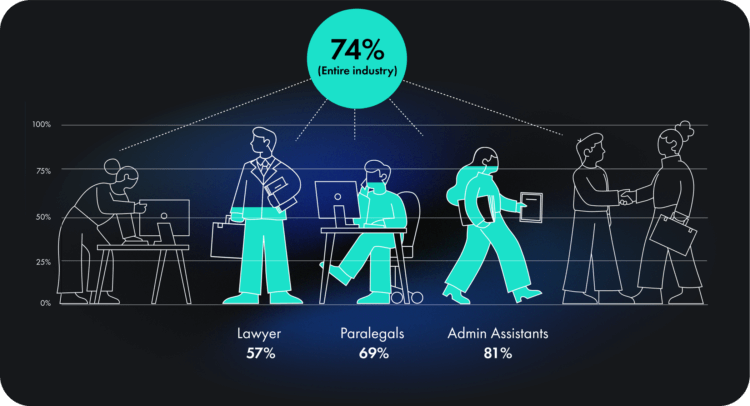Technology has fundamentally reshaped the legal profession and will continue to do so in the years ahead. In many cases, however, those same technological advancements that create new opportunities also present some of the top challenges facing law firms over the next five years.
Several of these industry shifts are described in Clio’s latest Legal Trends Report, including the following:
- The rise of AI-driven legal practices.
- Evolving billing models to meet client expectations and account for automation.
- Changing client expectations and demand for legal services.
So, what are the top challenges facing law firms in the next five years, and what can your firm do to turn these challenges into opportunities? Below, we’ll cover each of these topics in further detail, showing how, with the right approach, these hurdles could transform into launching pads for your practice.
Want more insights on the state of legal practice? Download the latest Legal Trends Report today.
AI is reshaping the legal industry
It’s fair to say that AI has already transformed the legal landscape, with the vast majority of law firms now using AI in some capacity. You’ve also likely seen some fairly significant changes in how your firm operates and provides services to clients.
With this rapidly evolving technology, law firms may need to look at what impact it can have on their business. For example, the rise of AI requires firms to reevaluate how they provide and charge for legal services. Namely, our analysis in the most recent Legal Trends Report discovered that nearly three-quarters of hourly billable tasks are potentially exposed to automation by AI.
In other words, AI’s automation potential is set to dramatically impact how law firms operate and deliver legal services—and firms that fail to recognize this may find themselves outpaced by other legal service providers.
Law firm billing models are evolving
One area where AI could present challenges for law firms is the impact of automation on billed time. Put simply, for firms that predominantly bill by the hour, AI automation reduces the time spent on a case, which means the firm has less to bill for and ultimately loses out on revenue.
As a result, many law firms will need to shift to alternative billing models, like flat fees, to offset the potential impact of automation on their revenue.
But AI isn’t the only reason why firms may need to reconsider their billing frameworks. As more and more firms offer alternative payment options, clients will come to expect a variety of payment options when engaging a law firm (already, 71% of potential clients want to pay their lawyers using flat fees, yet only half of firms offer flat fees as a potential payment method). Thus, a law firm’s payment offerings could soon make all the difference in whether a prospective client chooses to hire them.
You may like these posts
Client expectations are changing
As technology evolves, so do client expectations. Consider the uptake of online payments—once, it was common to pay bills in person or by mail. But as digital payment options became more widespread, people came to expect the convenience of paying online, often feeling frustrated when the option wasn’t available.
AI is driving a similar shift in expectations. With law firms integrating tools like virtual assistants and chatbots, prospective clients have grown accustomed to receiving immediate responses when visiting a firm’s website. In an environment where speed matters, being the first firm to engage with a potential client—or at least appearing to—can be the deciding factor in securing their business.
As a result, law firms should consider the use of AI-powered communication tools—from automated phone responses to personalized client portals—that provide 24/7 availability (or at least the perception of availability) and tailor their services accordingly.
What will be the greatest innovations to influence law firms in the next 5 years?
Law firm automation, assistance from AI, and the growing adoption of legal practice management (LPM) software will be the biggest innovations influencing law firm growth. With automation, firms can manage more tasks, serve more clients, and work from any location. In an increasingly digital world, it is critical for law firms to consider how technology can support both their short-term and long-term goals.
Learn more about automating your law practice with cloud-based legal practice management software—Watch how law firms use Clio.
The final word on the challenges facing law firms in the next 5 years
With so many technological advancements occurring (and many more no doubt on the horizon), it’s an exciting time to be a legal professional—but it’s also critical to remain mindful of the possible challenges that these advancements pose alongside the opportunities. Ultimately, the firms that will thrive in this new legal frontier will be those that can maintain flexibility and find the opportunities among the challenges, whether that involves adopting AI alongside new billing habits or leveraging new tools to help meet evolving client expectations.
When looking to embrace these opportunities, it pays to know the best resources for knowledge and insights. Download Clio’s Legal Trends Report today for insights on the most important issues facing the legal profession.
What are the biggest opportunities for law firms in the next five years?
The biggest opportunities for law firms in the next five years include leveraging AI for client communications, automating routine tasks, expanding access to legal services through technology, personalizing legal solutions with data analytics, and enhancing client experiences with 24/7 support and real-time case updates.
We published this blog post in November 2022. Last updated: .
Categorized in: Business
Create High-Impact OKRs and KPIs for Mid-Sized Firms
Setting strong OKRs and (or) KPIs for your law firm in Q1 is critical to driving success for the year. Watch this on-demand webinar to gain expert tips, examples, and guidance to shape strong 2025 goals!
Watch nowAdverse Costs Insurance as a Recoverable Disbursement? You Can't Always Get What You Want
">








